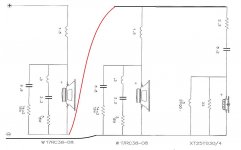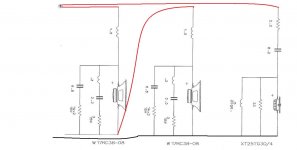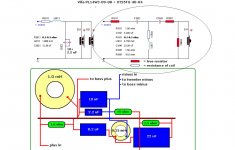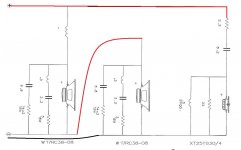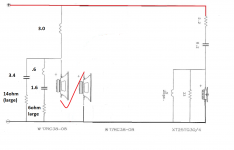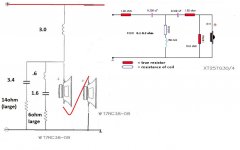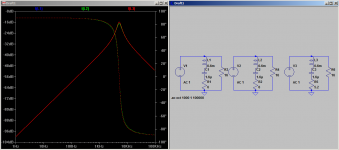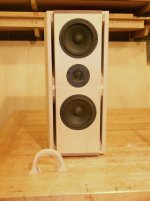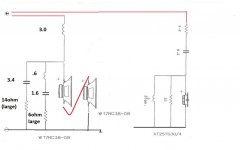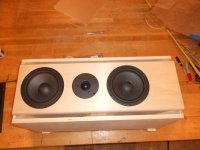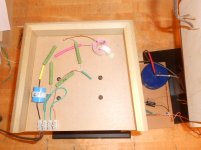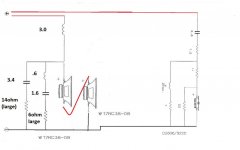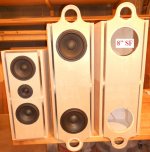Just wire the two woofers in series and adjust your crossover values for the new higher impedance. Treat the two speakers as one 16 ohm driver 🙂
Tony.
Tony.
Can't believe I missed the second part of that link/page aye crumba
Have these parts and this uses the same 8.2 series cap, were you suggestion to try this xo for tweeters?
Have these parts and this uses the same 8.2 series cap, were you suggestion to try this xo for tweeters?
I assume we are talking about Troels' two versions of the Vifa PL14WJ.
Vifa PL14WJ-
He seems to just scrape it on the d'Appolito version on levels and impedance by lowering resistance in the treble filter.
Since you re struggling with tweeter level here on a 4R parallel wired d'Appolito, why not try the easier series wired 16R version? It's altogether easier to implement anyway, and I like what it does. Very easy amplifier load. 🙂
Attachments
Oh like this 😕
I think the woofer(s) will sound awful without the filters.
I think the woofer(s) will sound awful without the filters.
Just wire the two woofers in series and adjust your crossover values for the new higher impedance. Treat the two speakers as one 16 ohm driver 🙂
Tony.
Attachments
Just pop the pair in where there is a single driver. Ditch the crossover for the second woofer. Double the inductances and resistances and halve the capacitances.
What Allen Said 😀 sorry I wasn't clear enough, I couldn't remember which doubled and which halved so just said adjust 😉 was too lazy to work it out!
Tony.
Tony.
I think I knew 1/2 of that 
Okay, will give this a try.
What size wire should I use for the .6 mH coil? (woofer)
Assuming 18 - 20 gauge for the .15 tweeter.

Okay, will give this a try.
What size wire should I use for the .6 mH coil? (woofer)
Assuming 18 - 20 gauge for the .15 tweeter.
Attachments
Last edited:
+1 Avoiding poor/dirty connections is more important.
With the drivers this way, for a given drive voltage the current for a each driver will be halved. The voltage across each driver will also be halved so the power is quartered, or -6dB.
With the drivers this way, for a given drive voltage the current for a each driver will be halved. The voltage across each driver will also be halved so the power is quartered, or -6dB.
Last edited:
Aye that much; might be looking for tweeter after all (that is less efficient).
The 88db Dayon with the screen/grill had some good reviews.
The 88db Dayon with the screen/grill had some good reviews.
+1 Avoiding poor/dirty connections is more important.
With the drivers this way, for a given drive voltage the current for a each driver will be halved. The voltage across each driver will also be halved so the power is quartered, or -6dB.
Attachments
me too 🙂 Doug the main concern with the gauge of the coil is DC resistance. Look at what that coil is in series with..... a six ohm resistor. You don't need to minimize the DCR of the coil just to show a big resistance in series with it again 🙂
I probably should do a sim to make sure what I am saying is actually factual (because it is L C R rather than L R C) but I think that if you had a high DCR coil as long as you reduce the R by the an appropriate ammount the total effect will remain the same.
OK I did a sim, L1 is 0.2 ohms DCR, L2 is 1 ohms DCR L3 is 1 ohms DCR with R5 reduced by 0.8 ohms to compensate for the extra resistance in the coil.
So as you can see, provided the overall resistance remains the same it doesn't really matter if it is in the coil or in the resistor 🙂
There may be some practical limits that I am unaware of, but using a lighter gauge wire in this instance should save money and space with no real downside.
Tony.
I probably should do a sim to make sure what I am saying is actually factual (because it is L C R rather than L R C) but I think that if you had a high DCR coil as long as you reduce the R by the an appropriate ammount the total effect will remain the same.
OK I did a sim, L1 is 0.2 ohms DCR, L2 is 1 ohms DCR L3 is 1 ohms DCR with R5 reduced by 0.8 ohms to compensate for the extra resistance in the coil.
So as you can see, provided the overall resistance remains the same it doesn't really matter if it is in the coil or in the resistor 🙂
There may be some practical limits that I am unaware of, but using a lighter gauge wire in this instance should save money and space with no real downside.
Tony.
Attachments
That's 6dB down from 95...the same as for a single driver.Aye that much; might be looking for tweeter after all (that is less efficient)
A tad OT, but... I once wound a coil for my 1st TQWT which was to notch out a breakup peak using only 1 extra component. Through sims in Boxsim I found I needed 48uH at a DCR between 0.5 and 1 Ohm. I wound it using 22ga on a M12 machine bolt, rough n ready. Took an LCR meter to it and tuned it to 48uH. DCR came out at 0.42 Ohm. The rest of the R was made up with a 0.47 Ohm resistor, but I took it out in the end, the coil was just right as is. I have more trouble with RC shunt resistances being a bit high.
Okay sorry for the delay...
So working very nice - best so far.
A MTM with 16ohm woofer connection and the Vifa original xo (didn't want to change to many things at once)
The bass is about the same (still plenty) the middle is nice and natural, better than the high mounting idea.
The treble is probably to high; hovering around either too low or to high.
Delightful sound though Thanks guys!!
Thanks guys!!
***
16ohm load (I guess) now I can bridge two amps and not worry.
So working very nice - best so far.
A MTM with 16ohm woofer connection and the Vifa original xo (didn't want to change to many things at once)
The bass is about the same (still plenty) the middle is nice and natural, better than the high mounting idea.
The treble is probably to high; hovering around either too low or to high.
Delightful sound though
 Thanks guys!!
Thanks guys!!***
16ohm load (I guess) now I can bridge two amps and not worry.
Attachments
Now why I didn't think of that?
Just kidding Steve, Thank You!
Just kidding Steve, Thank You!
Since you re struggling with tweeter level here on a 4R parallel wired d'Appolito, why not try the easier series wired 16R version? It's altogether easier to implement anyway, and I like what it does. Very easy amplifier load. 🙂
I think this is the last go  but seems like always getting better.
but seems like always getting better.
Changed out tweeter The Madisound Speaker Store
Combined xo from the SF 8"/combination (which is pretty basic) to existing. Tried it without the L pad first - too much high, so put that back in: R1 2.2, R2 22, -3db, which also means could use a 88db tweeter (like the Dayton).
Would build this again, delightful sounding pair of speakers.
 but seems like always getting better.
but seems like always getting better.Changed out tweeter The Madisound Speaker Store
Combined xo from the SF 8"/combination (which is pretty basic) to existing. Tried it without the L pad first - too much high, so put that back in: R1 2.2, R2 22, -3db, which also means could use a 88db tweeter (like the Dayton).
Would build this again, delightful sounding pair of speakers.
Attachments
Success with the new tweeter experiment; changed R22 a few times, ended up replacing R22 with 2 - 4.7ohm (9.4ohm).
This tweeter just sounds better, a much better blend - overall.
The 16ohm hookup seems to make the amplifier work harder; not complaining, the 6.5s have a monster stomping around sound to them. (maybe the side ports work...I don't really know).
Wondering what to do with all these extra boxes for the 8" version 🙄
This tweeter just sounds better, a much better blend - overall.
The 16ohm hookup seems to make the amplifier work harder; not complaining, the 6.5s have a monster stomping around sound to them. (maybe the side ports work...I don't really know).
Wondering what to do with all these extra boxes for the 8" version 🙄
Attachments
- Status
- Not open for further replies.
- Home
- Loudspeakers
- Multi-Way
- Canned Crossover Design - What Next?
